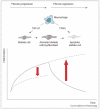Targeting the stromal microenvironment in chronic inflammation
- PMID: 16682252
- PMCID: PMC3119430
- DOI: 10.1016/j.coph.2006.03.007
Targeting the stromal microenvironment in chronic inflammation
Abstract
A characteristic feature of chronic inflammatory reactions is their persistence and predilection for certain sites. The molecular basis for such tissue tropism (as, for example, seen with metastatic spread) has until recently remained obscure, but recent studies have strongly implicated tissue-resident, stromal cells, such as macrophages, endothelial cells and fibroblasts. These cell types make attractive therapeutic targets as they help define the three-dimensional structure of tissues and are key orchestrators of the inflammatory infiltrate. Most current anti-inflammatory therapies target immune cells in an attempt to inhibit the production of pro-inflammatory mediators; however, an equally important target is the active induction of anti-inflammatory mediators involved in the resolution of inflammation. Recent work suggests that stromal cells are an important source of these mediators. Targeting of multiple signals may be required to inhibit tissue damage associated with inflammatory disease. Cells of the monocyte lineage are present as tissue-resident cells and interact closely with other stromal populations. These cells form an ideal target for modulation of the inflammatory environment as, in some cases, they appear to induce tissue repair. Therapeutic manipulation of the stromal microenvironment has been particularly effective in treating cancer and is likely to provide a novel method to achieve improved control of chronic inflammatory disease.
Figures


References
-
- Buckley CD, Pilling D, Lord JM, Akbar AN, Scheel-Toellner D, Salmon M. Fibroblasts regulate the switch from acute resolving to chronic persistent inflammation. Trends Immunol. 2001;22:199–204. - PubMed
-
-
Parsonage G, Filer AD, Haworth O, Nash GB, Rainger GE, Salmon M, Buckley CD. A stromal address code defined by fibroblasts. Trends Immunol. 2005;26:150–156. This review summarises recent findings showing that fibroblasts help define a tissue-specific area postcode, similar to the vascular area postcodes controlling leucocyte egress from the blood into tissue.
-
-
- Bjornson CR, Rietze RL, Reynolds BA, Magli MC, Vescovi AL. Turning brain into blood: a hematopoietic fate adopted by adult neural stem cells in vivo. Science. 1999;283:534–537. - PubMed
-
- Mueller MM, Fusenig NE. Friends or foes — bipolar effects of the tumour stroma in cancer. Nat Rev Cancer. 2004;4:839–849. - PubMed
Publication types
MeSH terms
Substances
Grants and funding
LinkOut - more resources
Full Text Sources

